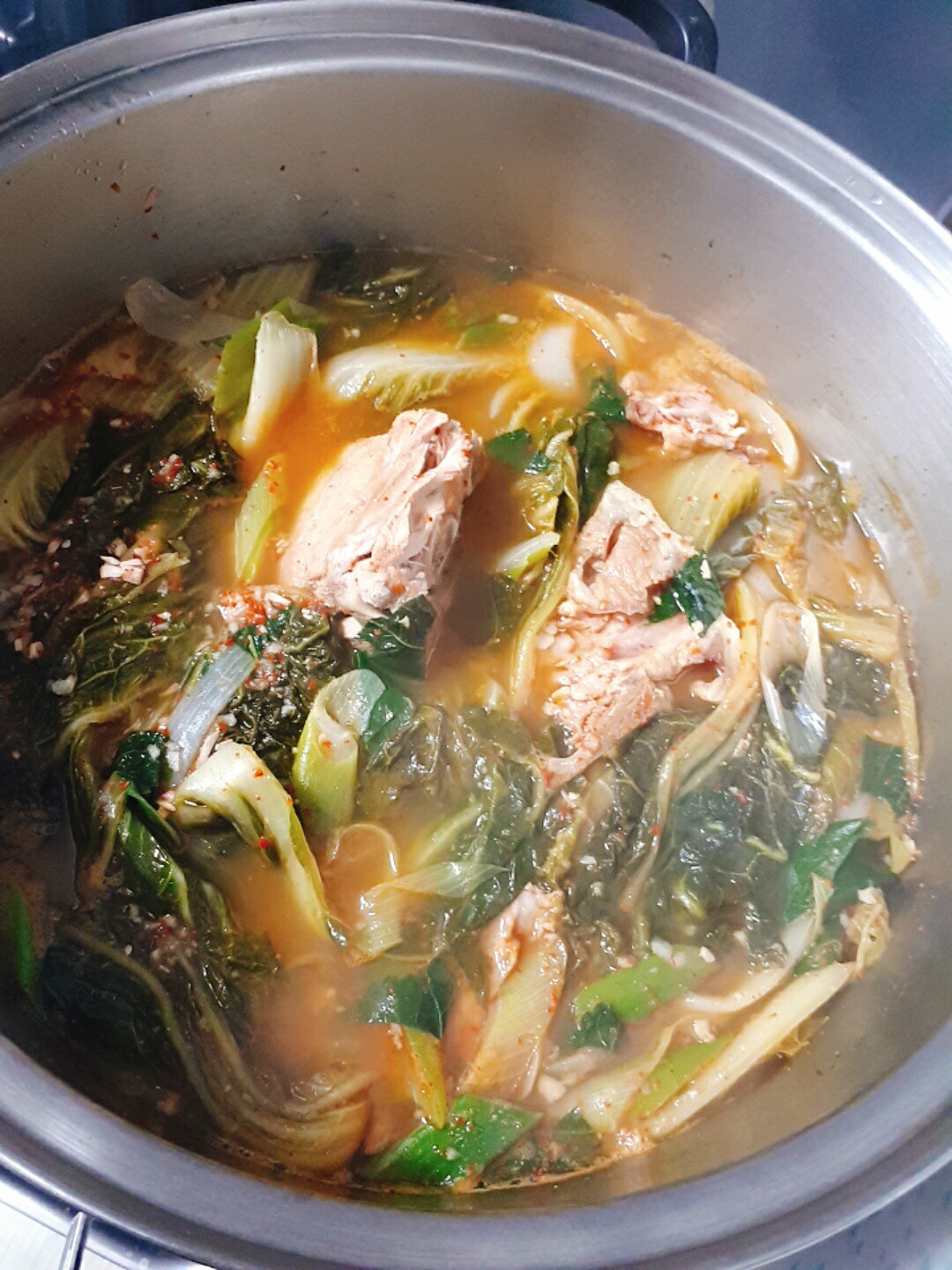Hearty Pork Bone and Napa Cabbage Stem Soup (Guk)
Enjoy Rich Pork Bone and Napa Cabbage Stem Soup at Home!

Make a generous batch of hearty pork bone and napa cabbage stem soup using the abundant outer leaves from napa cabbage, perfect for kimchi, and affordable pork back ribs. This recipe yields a deeply flavorful and satisfying meal or a wonderful large-batch side dish to share.
Main Ingredients- Pork back ribs (gamjatang style) 3kg
- Napa cabbage outer leaves (uguji) 2kg
- Green onions 2
- Perilla leaves 10
- Onion 1
- Bay leaves 10
- Ginger 2-3 pieces
- Soju 1 bottle
Seasoning and Broth Ingredients- Doenjang (soybean paste) 3 Tbsp
- Gochugaru (red pepper flakes) 5 Tbsp
- Minced garlic 3 Tbsp
- Black pepper powder 1 tsp
- Ginger powder 1 tsp
- Cooking wine or Mirin 1 cup (can substitute for rice wine with ginger)
- Salt 1 Tbsp (for seasoning)
- Doenjang (soybean paste) 3 Tbsp
- Gochugaru (red pepper flakes) 5 Tbsp
- Minced garlic 3 Tbsp
- Black pepper powder 1 tsp
- Ginger powder 1 tsp
- Cooking wine or Mirin 1 cup (can substitute for rice wine with ginger)
- Salt 1 Tbsp (for seasoning)
Cooking Instructions
Step 1
Prepare 3kg of pork back ribs (also known as gamjatang ribs). Submerge them completely in cold water and soak for at least 4 hours to overnight to remove blood. Change the water once or twice during soaking. Thoroughly draining the blood is crucial to prevent any gamey smell in the final soup.

Step 2
Place the blood-drained ribs in a pot and cover with water. Add sliced ginger, 1 green onion, about 6-7 bay leaves, and the entire bottle of soju. Bring to a boil and simmer for about 10 minutes. Discard this cooking water, and rinse the ribs thoroughly under cold running water to remove any impurities or bone fragments stuck between the bones and meat. (Rinsing under cold water helps dislodge these particles effectively. You can use fresh green onions if dried ones are not available.)

Step 3
Return the cleaned ribs to the pot. Fill with enough water to generously cover the ribs. Add the remaining 3-4 bay leaves, 1 cup of cooking wine (or mirin, which acts similarly to rice wine with ginger), and dissolve 3 tablespoons of doenjang (soybean paste) into the water. Add some black pepper powder. Skim off any scum or fat that rises to the surface during simmering; this will make the broth clearer and cleaner.

Step 4
After skimming the fat, stir in 5 tablespoons of gochugaru (red pepper flakes), 3 tablespoons of minced garlic, and 1 teaspoon of ginger powder. Cover the pot and let it simmer on low heat for at least 2 hours. This long simmering time allows the deep flavors from the pork bones to infuse into the broth. The longer it simmers, the richer the soup will become.

Step 5
Prepare the napa cabbage outer leaves (uguji) which will add great flavor to the soup. Blanch the leaves in boiling water for about 5 minutes until tender. (You can blanch them just before adding, or blanch them ahead of time and store them in cold water. Using pre-blanched radish greens (siraegi) or other types of boiled cabbage leaves is also a good option.)

Step 6
Add the blanched napa cabbage leaves to the pot of simmering pork bone soup. Ladle some of the hot broth over the cabbage leaves to help them absorb the flavor. Continue to simmer, covered, on low heat for another 30 minutes, allowing the cabbage stems to soften and meld with the soup’s flavors.

Step 7
Cut 1 onion into large chunks and the remaining green onion into large pieces. Add them to the pot. Simmer for another 5-10 minutes, or until the onion pieces are tender. Taste the soup and adjust the seasoning with salt if necessary. It’s important to season according to your preference.

Step 8
Wash 10 perilla leaves and cut them into manageable pieces. Sprinkle the cut perilla leaves over the finished soup and simmer for just 1-2 minutes. This will add a fresh, aromatic touch to the soup.

Step 9
Your hearty pork bone and napa cabbage stem soup, made with fresh outer cabbage leaves, is now ready! This delicious soup, paired with some crunchy kimchi, will surely make two bowls of rice disappear quickly. Perfect as a large-batch side dish for those times when eating out is difficult, ensuring a satisfying meal for the whole family.



